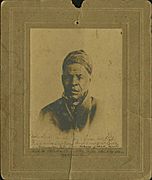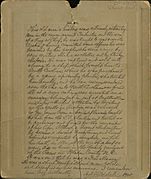Omar ibn Said facts for kids
Quick facts for kids
Omar Ibn Said
|
|
|---|---|

Restored and colourised ambrotype of Omar ibn Said, c. 1850
|
|
| Born |
Omar ibn Sayyid
1770 Imamate of Futa Toro
|
| Died | 1864 (aged 93–94) |
| Other names | Uncle Moreau, Prince Omeroh |
| Education | Formal Islamic education in Senegal |
| Known for | Islamic scholar, author of slave narratives |
Omar ibn Said (Arabic: عمر بن سعيد ʿUmar bin Saeed; 1770–1864) was an important Fula Islamic scholar from Futa Toro in West Africa. This area is now part of Senegal. In 1807, he was captured and forced into slavery. He was then taken across the Atlantic Ocean to the United States.
Omar ibn Said remained enslaved for the rest of his life. During this time, he wrote many works in Arabic. These writings included books about history and religion. He also wrote a short book about his own life.
Contents
Omar's Early Life and Capture
Omar ibn Said was born in 1770 into a wealthy family. His home was in the Imamate of Futa Toro, an Islamic state in West Africa. This state was located along the Senegal River.
He was a very educated person and an Islamic scholar. For 25 years, he studied with important Muslim teachers. He learned many subjects, including math, astronomy, business, and religion.
In 1807, Omar was captured during a war. He was then forced into slavery. He was taken across the Atlantic Ocean to the United States.
Life as an Enslaved Person
Omar ibn Said first arrived in Charleston, South Carolina. He escaped from a cruel master there. He then traveled to Fayetteville, North Carolina.
In Fayetteville, he was recaptured and put in jail. Later, he was sold to James Owen. Omar ibn Said said that Owen was kind to him.
The Owen family was impressed by Omar's education. They gave him an English translation of the Quran. He also received an Arabic translation of the Bible. Francis Scott Key, who wrote "The Star-Spangled Banner," helped him get this Bible.
Omar ibn Said had chances to return to Africa. However, he chose to stay in the United States. He was not sure if his family or people were still safe there. He lived to be in his mid-nineties. He was still enslaved when he died in 1864. He was buried in Bladen County, North Carolina. People also knew Omar ibn Said as Uncle Moreau and Prince Omeroh.
His Faith and Writings
Omar ibn Said officially became a Christian on December 3, 1820. However, some people question if he truly changed his religion. In his Bible, he wrote notes praising Muhammad. He also wrote an Islamic prayer, Surat An-Nasr, on a card in 1857. This prayer talks about many people becoming Muslim.
On the back of this card, someone else wrote in English. They incorrectly said the prayer was the Lord's Prayer. They also wrote that Omar was a good Christian.
Other people who wrote about Omar said he was Christian. But his own writings are not as clear. In his autobiography, he still praised Muhammad when talking about his life in Africa. His words about "Jesus the Messiah" are similar to how Jesus is described in the Quran. He used an Islamic title for prophets when calling Jesus "our lord/master." This is not the same as calling God "Lord."
Some experts believe Omar wrote his autobiography for two groups of people. White readers might have seen it as proof of his Christian conversion. But Muslim readers might have understood hidden meanings. They might have seen that he was still a Muslim, using a practice called Taqiya to hide his faith while facing hardship. This way, his writings could show the unfairness of slavery to many different people.
Important Manuscripts
Omar ibn Said wrote fourteen Arabic manuscripts. The most famous is his autobiography, The Life of Omar Ibn Said. He wrote it in 1831.
This book tells about parts of his life. It also shows his strong belief in Islam. It talks about his respect for other people who believed in God. On the surface, the book might seem to accept slavery. But it starts with Surat Al-Mulk, a chapter from the Qur'an. This chapter says that only God has power over humans.
This autobiography is the only known Arabic life story written by an enslaved person in the United States. It was sold between private collectors. In 2017, the Library of Congress bought it. It has been cared for and can now be seen online.
Most of Omar's other works were Islamic writings in Arabic. This includes a handwritten copy of some short chapters (surat) from the Qur'an. These are now kept at the University of North Carolina at Chapel Hill. Omar wrote these from memory. He made a few small mistakes, especially at the start of Surat An-Nasr.
His Bible, which was an Arabic translation, has notes written by Omar. This Bible is part of a special collection at Davidson College. Omar also wrote a letter in Arabic in 1819. It was sent to James Owen's brother, Major John Owen. This letter has many references to the Quran. It also includes geometric symbols, which might have had a special meaning. This letter is now at Andover Theological Seminary.
Omar's Legacy
In 1991, a mosque in Fayetteville, North Carolina was renamed in his honor. It is now called Masjid Omar ibn Sayyid.
An opera named Omar was inspired by ibn Said's life. Rhiannon Giddens and Michael Abels wrote it. The opera first opened on May 27, 2022, in Charleston, South Carolina.
Gallery
See also
 In Spanish: Omar Ibn Said para niños
In Spanish: Omar Ibn Said para niños
- Islam in the United States
- List of slaves





